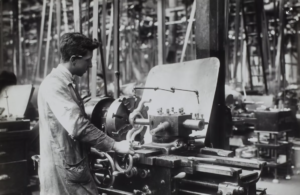Most modern methodologies and systems adopted in the automotive industry, stem from the innovations introduced by Henry Ford: a set of high-capital, mass-production methods designed for economies of scale and repetition — in short, the assembly line.
Over the years, the industry has adapted to newer trends. It switched to smart manufacturing and digitized some processes. Also, there’s an inclusion of modern process management methods: lean manufacturing, six-sigma, the theory of constraints, and so on.
However, by and large, the industry continues to base its systems on the concept of the assembly line. On the other hand, the global trends reflect a sharp need for features like digitization, mass customization, automation, sustainable manufacturing procedures, and more. Even though automotive manufacturers invest heavily in automation, Industry 4.0 is still a long way off. In order to bridge this gap, assembly line methods will need a drastic digital and agile transformation.

The traditional assembly line has dominated automotive manufacturing for decades. Today, the manufacturers compete not only in terms of who can produce more and scale the production chain. What we see at play are actually totally opposite approaches to scalability and automatization.
The first approach, the so-called “Gigafactory”, belongs to one of the most influential and prominent entrepreneurs of the 21st century – Elon Musk. That way of thinking lies behind the emergence of enormous manufacturing facilities that can produce the batteries and vehicles that will move humanity toward greener transportation.
On the other hand, there is an absolutely different concept of the design for a manufacturing process called the “Microfactory”. The term was coined in 1990 by the Mechanical Engineering Laboratory of Japan. It captures the idea of a smaller manufacturing footprint, employing cell-based manufacturing and higher levels of automation, to deliver more customizable designs.

“Microfactory” is a small-to-medium-scale, highly automated manufacturing setup. It re-imagines the process of building an automobile, and adopts a modular, manufacturing “cell” over the traditional assembly line. In a “Microfactory”, each individual cell is capable of manufacturing multiple vehicle designs from the ground up. Moreover, “Microfactory” is also able to fulfill the following extremely significant options:
- Customizability: Increased demand for bespoke products.
- Rapid Innovation and Process Adaptability: Ability to adapt to newer technological trends such as 3D printing and smart manufacturing tech.
- Smart Products: Increased demand for data integration and human-digital interactions
- Supply chain resilience: Ability of the supply chain to withstand global calamities such as the COVID-19 pandemic.
“Microfactories” are high-technology-driven, and their efficiency depends on advanced computing, robotics, and AI tech. A host of IT services can be used to transit to a microfactory-as-a-service model and catalyze further development.
Many growing manufacturers have started investing into the “Microfactories” today. We also see some established auto makers showing interest in “Microfactories” because it’s a great solution to the growing demands of the Automotive industry. This concept, with its high adaptability and lean production methods, can serve as a great push for automotive industry toward Industry 4.0 standards.





